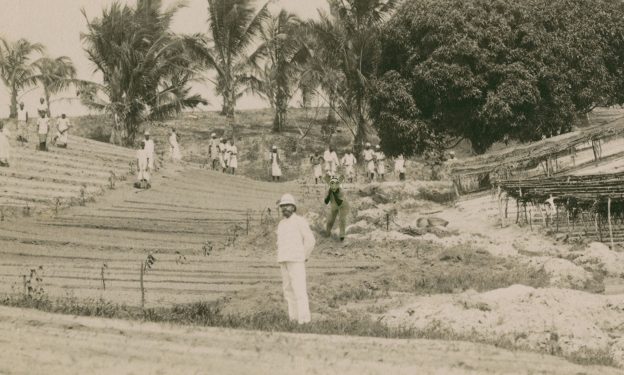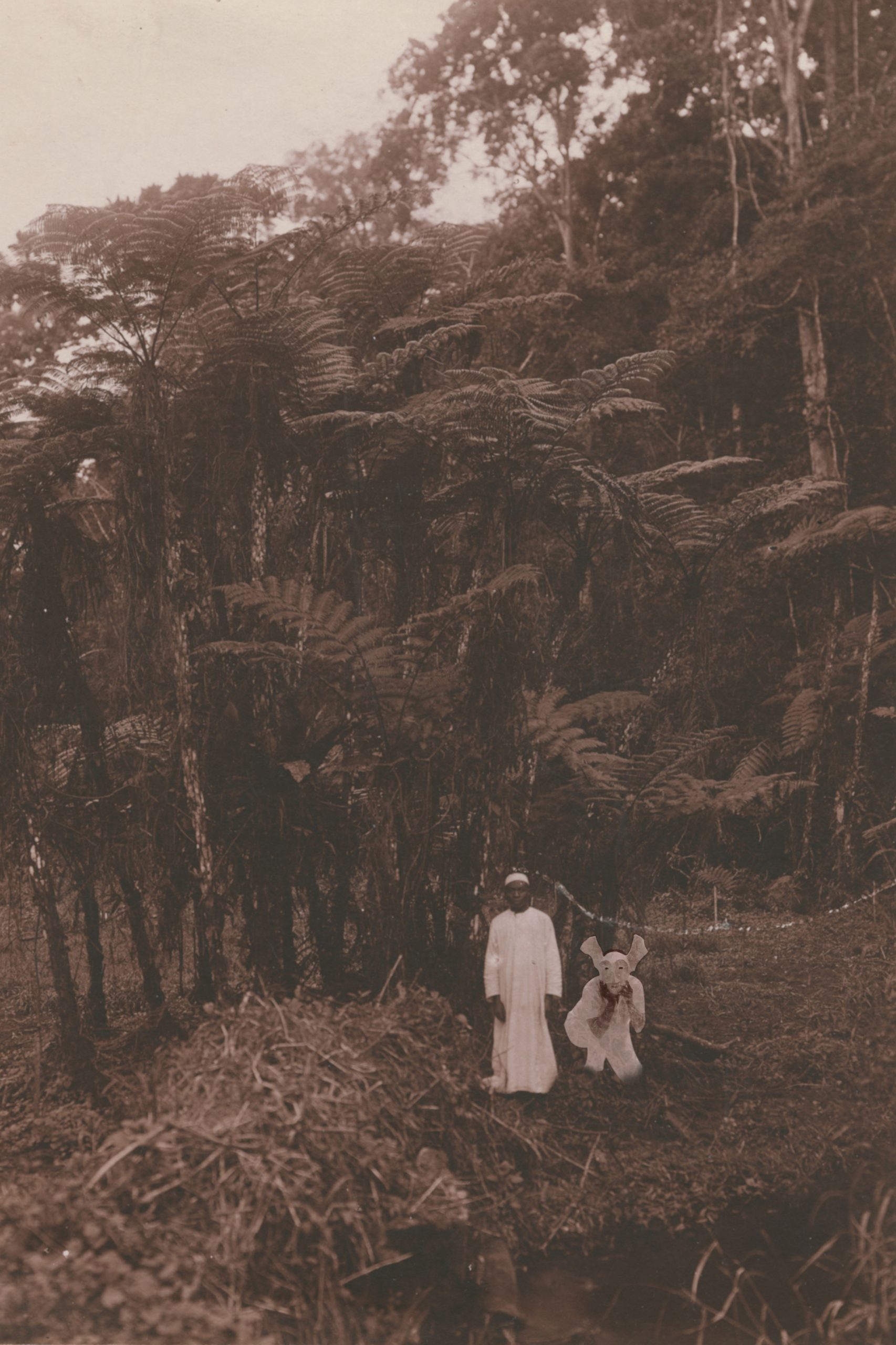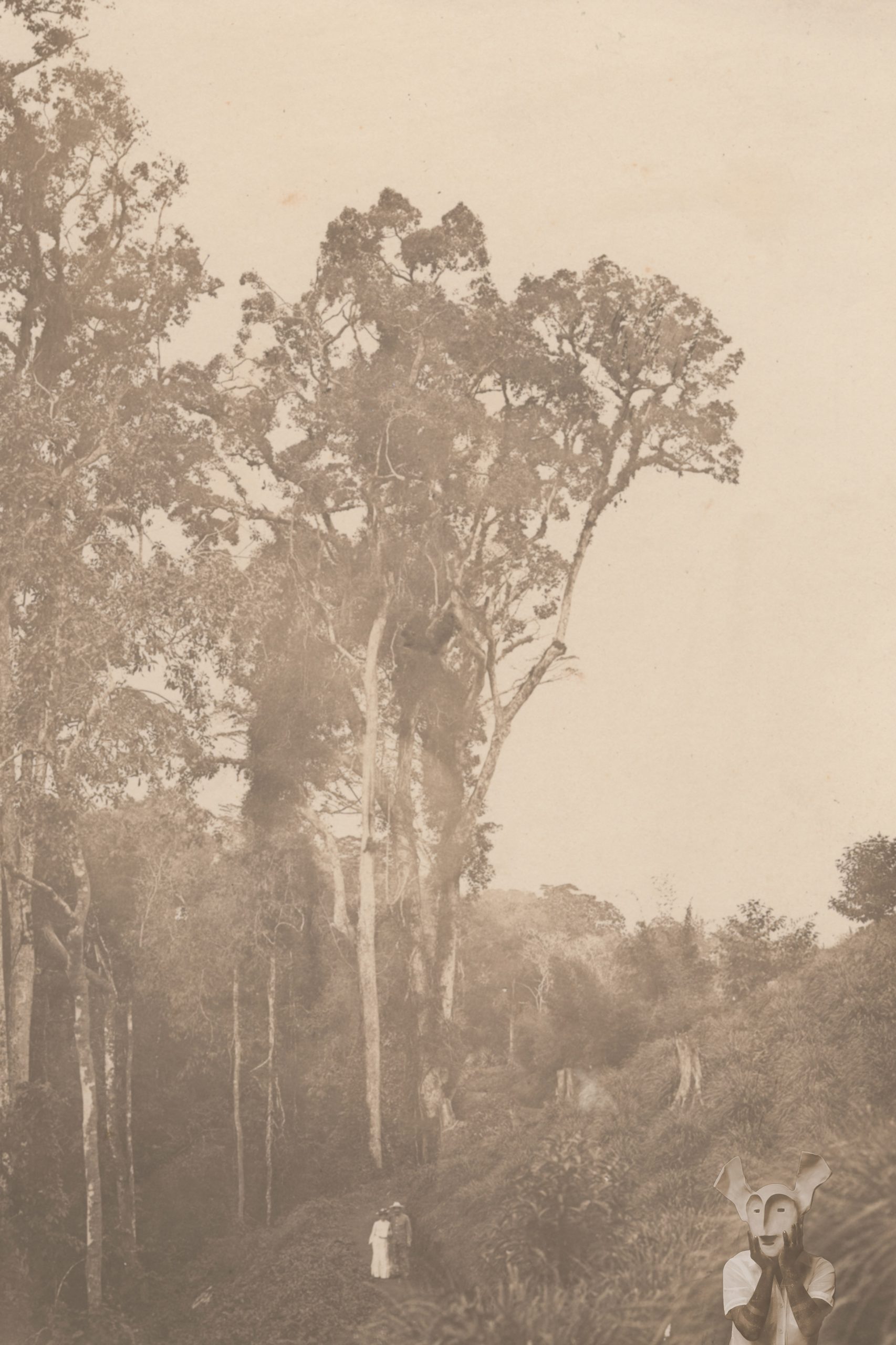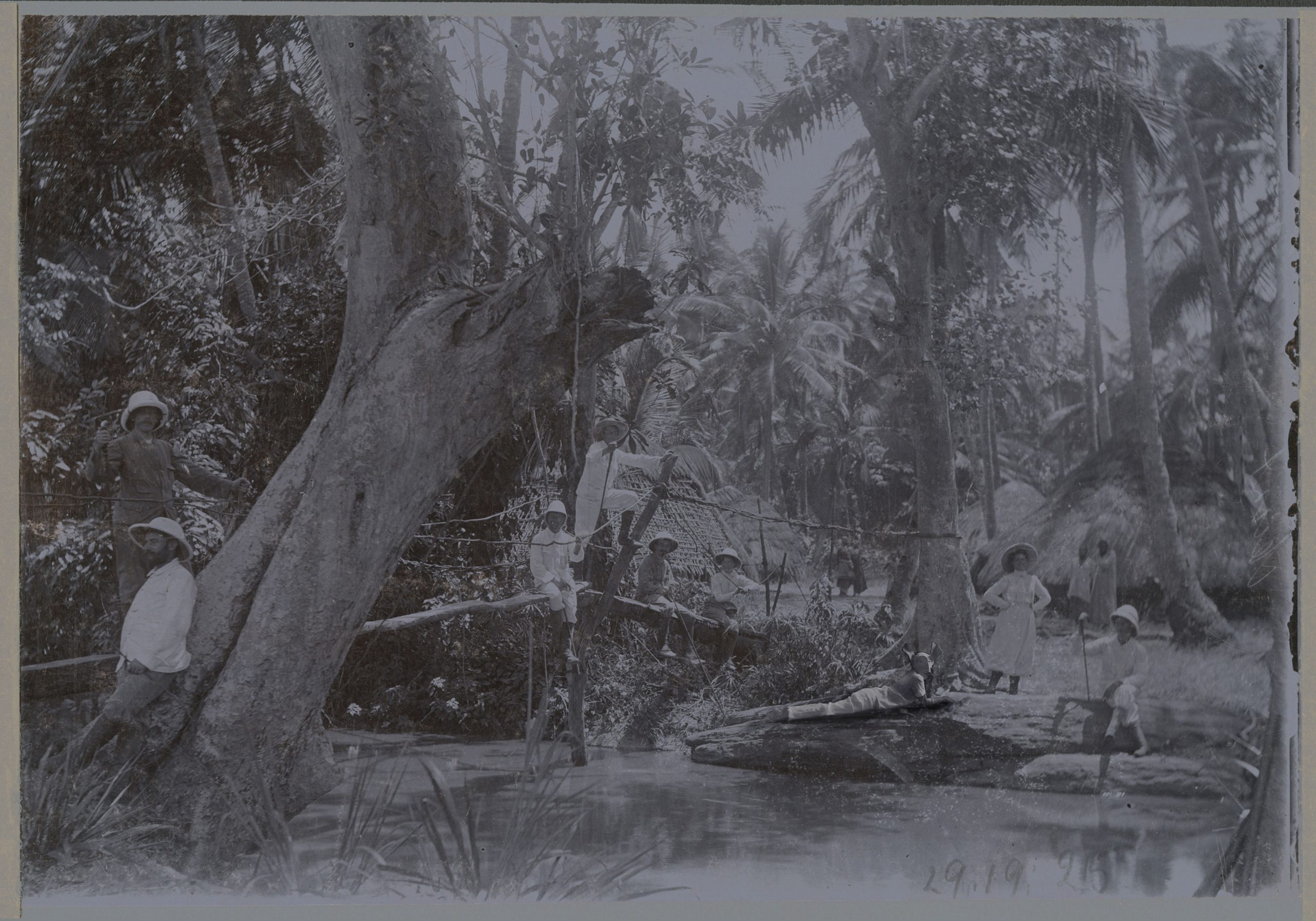with KASPALE’S ARCHIVE INTRUSION
an artwork by SYOWIA KYAMBI
Read this essay in French — Read this essay in Russian
IMITATION GAME
On May 30th 2020, a local small business owner, a fifty-one-year-old Black Brazilian woman, had her neck stepped on for several minutes by a military police officer during a police intervention. Her leg was broken and several wounds inflicted, and later she was unjustifiably arrested. This scene, like many similar scenes, took place in the periphery of the city of São Paulo. Bystanders filmed the entire incident, and the videos went viral on social media, as well as on local and international news outlets.
Earlier on that day, according to the BBC, the paulista military police patrol responded to a noise-nuisance complaint in the area. Upon arrival, the military police officers identified a car playing loud music as the origin of the disturbance. Parked in front of the local business, a bar, they approached the driver: a “non-identified male individual” who was reportedly a regular customer of the bar. The woman watched her customer giving the cops a hard time by resisting the order to turn in his car keys. This refusal irritated the military police officers, igniting the session of abuses and physical aggressions against both the woman and the customer.
The woman, on condition of anonymity given her fears of retaliation, said she had intervened in the scene she was witnessing by trying to stop the abusive manner the two cops were detaining her customer. An independent media outlet interviewed her: “the young man [the customer] had been beaten up a lot already. He was on the ground. I asked for the police soldier to stop the attacks but then, the second cop threw me up against the fence.”
As she recounted, she was hit before having her neck stepped on. “I got dizzy with the blows, then he tripped me up. His low kick broke my tibia. When I told him that, the cop cursed at me and stepped on my neck.” She claims not being able to recall how long she had a military boot pressing her neck, rubbing her face against the ground.
“It wasn’t for a short time, no. He had his full weight on. Then he dragged me and scraped my face against the asphalt before throwing me on the sidewalk. And then [again] he knelt down on both my neck and ribs. I thought I would die like George Floyd.” – Ponte Jornalismo
This scene came to light on the verge of Black Lives Matter demonstrations, triggered by George Floyd’s murder in Minneapolis, USA. While it is impossible to assert whether the military police officer was acting, or rather, was inspired1 by the Minneapolis police officer who murdered George Floyd under both his custody and knee, the Brazilian cop showed little-to-no sensitivity when performing this more-than-ever symbolic act.
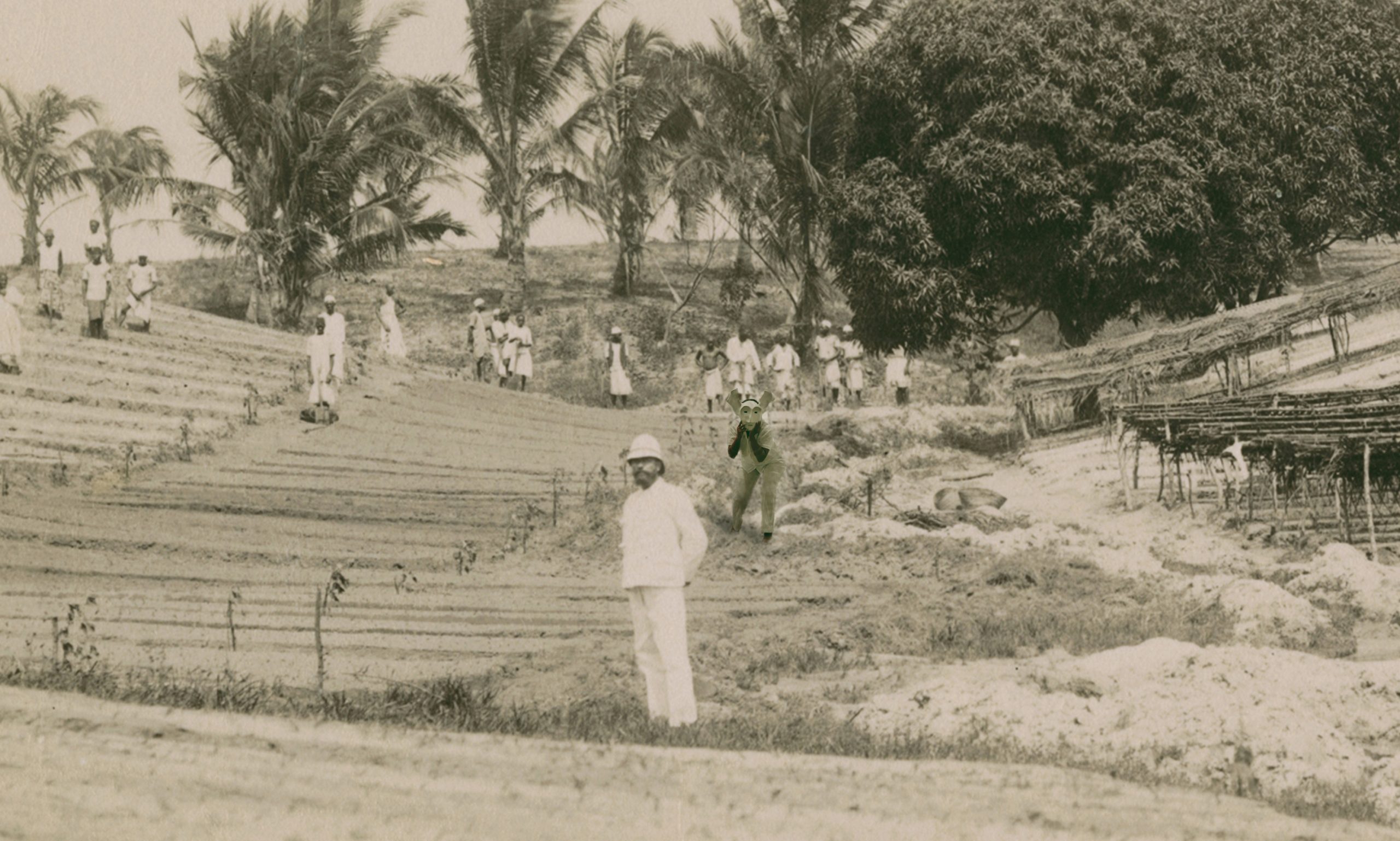
THE BRAZILIAN NECROSTATE
In 2015, I studied the Brazilian police brutality phenomenon for my Criminology and Forensics Studies master’s degree at the Maastricht University in the Netherlands. I titled my thesis “Brazilian Military Police: A Culture of Brutality,” and I aimed to understand the multilateral factors that contributed to such rampant violence. I also sought to examine whether or not the militarized nature of the Brazilian police, an inheritance from dictatorship, is responsible for the force’s brutal reputation. Unsurprisingly, when reviewing the statistics five years later, the cases of torture, abduction, humiliation, and systematic misuse of deadly force have only increased. Today, more than ever, Brazil exemplifies what Achille Mbembe calls a “necropolitical state.” And, this characterization has gained remarkable relevance under Bolsonaro’s government.
Brazilian police killed at least 5,804 civilians in 2019, compared with 5,716 in 2018, 75% of those killed being Blacks or Pardos (Browns). Such numbers do not reflect cases that were never reported, and do not comprise, for example, cases of torture, which are often followed by death. Although difficult to determine the exact scale of the real problem, the reported numbers alone are alarming enough.
Such violence isn’t, however, an incidental abnormality or a “social-pathology.” Instead, it must be considered a structural phenomenon: police brutality is, rather, a normalizer of everyday life, a constituent element of both the personal and the collective unconsciousness. As Mark Lanier and Stuart Henry describe in seeing violence of this type, committed by a legitimate government, people become numb and indifferent.
The history of Brazil and of the Americas (as in any colonized/occupied territory) is founded on violence. Brazil’s colonial period began in 1500 with the Portuguese arrival. Brazil was a ferociously exploitive colony, economically based on the extraction of wood, the mining of gold and diamonds, and sugar production. Millions were enslaved and brought from Africa, and, together with the few remaining native people (the ones who survived the European occupation/spoliation), were the fuel for the colonial productive system. In 1815 the country became an empire, and in 1889, for the first time, a republic. Slavery was legally ended only 132 years ago, in 1888. In the contemporary era, Brazil’s democracy is considered young and precarious; it was in 1988, after decades of military dictatorship, that a constitution was promulgated, introducing the country to universal elections and stating fundamental rights of the citizens, and finally setting labor regulations, rights to education, public health, and social security.
VESTIGES OF AN AUTHORITARIAN ERA
The remains of an ultraviolent, nearly five-hundred-year authoritarian epoch were also passed along in the Brazilian democratic law. A number of legal devices worthy of authoritarian regimes were drafted together with a soft transition from a dictatorship to a democratic state, made possible by a “blanket amnesty”—a type of amnesty that shielded and excused from prosecution every single public official responsible for human rights crimes committed during that era.
The word “amnesty” comes from the ancient Greek word anamnesis (recollection or remembrance of the past; reminiscence). Brazilian philosopher Vladimir Safatle suggests that this type of amnesty—and its subsequent lack of accountability and justice—exercises a phantasmagorical and strong influence on a society’s psyche. Safatle explains that, in the Brazilian case, the amnesty allowed the armed forces to get away with crimes of torture and the concealment of corpses without admitting mea culpa. All the crimes committed during the dictatorship were buried under such forgetfulness, hindering the victims’ families from the elaboration of a necessary mourning. To never find out what happened to the victims—where and under which conditions their bodies were disposed, and, mainly, to realize that no perpetrator will ever be held responsible—taints the whole mourning process. Safatle concludes that these forgotten dead evoke Lacan’s symbolic order. “What is expelled from the symbolic universe returns and earns shape in the real universe.” That is, the inability to deal with such a brutal past, alongside with a complicated and disenfranchised grief, can explain a lot of the violent situation in the country. The mourning can be considered pathological when the grief is impossible to deal with. Therefore, the psychological condition the Brazilian society demands consideration.
THE ORGANIZATION’S SHAPE AND ITS PURPOSES
The Brazilian police surged as an organized institution in the early 1800s, mainly to protect and control the circulation of commodities and to ensure the ‘public order’. The Military Police of Rio de Janeiro, for example, was formed on May 13, 1809. As suggested by researcher Patrick Ashcroft, almost every police action between 1810 and 1821 related to enslaved people. At that time, the enslaved were a sui generis ‘commodity’ (legally speaking ‘a thing’) that needed to be controlled2.
In time, it becomes clear that the police in Brazil were not designed for democratic purposes. Their modus operandi, overall, remains quite familiar: the same police force that pursues, kidnaps, tortures, kills, and conceals bodies of Afro-Brazilians today is the police force that chased fugitive enslaved people, applied punishments, broke into capoeiras, and patrolled expression of African culture and rituals of any kind back in the post-colonial times.
The Brazilian police structure is also problematic. It is peculiarly divided into two branches: the military police and the civil police. The military police are responsible for the ostensive patrolling and maintenance of the public order, performing arrests only in cases of blazing offence, in flagrante delicto. The military branch serves as a reserve troop and ancillary force of the Brazilian Army and, at the same time, the military police commonly interact with the public. In turn, the civil police have attributions of judiciary police, conducting investigations, and exercising police inquiry.
Political scientist Luiz Eduardo Soares suggests that, if the military police lack investigative and forensic powers and can only catch criminals “in the act,” the same police force will understand “arresting” as a synonym of “productivity.” Soares explains further: productivity is assessed by fast and large positive statistical results (e.g., arrests made, seizure of weapons, drugs and illicit material, etc.). Thus, military police officers will do whatever it takes to bring results by arresting people in the act—including modifying crime scenes. As reported by HuffPost, the “flagrant kit” is, for example, a widely known fraudulent practice, consisting of the alteration of the crime scene by planting a revolver with scratched register number and small amounts of prohibited drugs, such as marijuana, crack, or cocaine. Such “kits” have been found inside police officer’s lockers on many occasions. Thus, one may say that, when it comes to showing efficiency, the military police go out to hunt.
This military nature indicates that the police force will be organized in the same fashion as the army. However, differently from the army, an ideal police officer should play a role in preserving and guaranteeing citizens’ rights, material property, physical safety, and in case of necessity, making use of measured force. The police intervention must follow specific guidelines when dealing with civilians: warning, persuasion, physical force, and lastly, lethal techniques. The army, on the other hand, serves completely different objectives: territory defense, sovereignty assurance, and warfare challenges.
Soares highlights that the organizational shape of any institution is a significant factor for the behavioral standards of its members. If the Brazilian police are an organization of military nature, how do we expect the police not to see almost every civilian (especially those historically and markedly marginalized) as a potential enemy?
A PERMANENT STATE OF EXCEPTION
Aside from extreme violence, the military police are particularly racist. The statistics, as well as the countless emblematic cases that flood the news and permeate our collective imaginary, give us the impression that police brutality is a uniform phenomenon that singles out a certain demography and geography to operate. This impression is reinforced by the ever-present characteristics of the victims: young, underprivileged Black males living in favelas. Certain areas, sectors, and individuals clearly suffer more with violent police intervention than others. Racial profiling, for example, is not at all a veiled practice: in 2013, São Paulo’s military police leaked an institutional order commanding the particular approach of Black and Pardos individuals. As Giorgio Agamben might suggest, the “state of exception” in the favelas—where the “controls and guarantees of judicial order can be suspended”—is no longer a mere “temporary suspension” of the state of law (the right to kill and those who are exposed to this death); it is, actually, a permanent and normalized spatial arrangement.
Scholar Silvio de Almeida understands that such structural racism is an essential technology for the exercise of power that decides “who lives and who dies.” De Almeida draws attention to Achille Mbembe’s concept “necropolitics.” While Mbembe’s concept is built on Michel Foucault’s notion of “biopower” (the domain of life over which political power has taken control), Mbembe considers the concept of biopower too Eurocentric and, therefore, insufficient to account for contemporary forms of the subjugation of life to the power of death taking place within the confines of the third world. Mbembe puts forward the notion of necropolitics to explain the
various ways in which, in our contemporary world, weapons are deployed in the interest of maximum destruction of persons and the creation of death-worlds, new and unique forms of social existence in which vast populations are subjected to conditions of life conferring upon them the status of living dead.
Mbembe brings to the center of the political debate the ways in which power, through its governmentality3 devices, appropriates death as an object of management. Power no longer establishes only norms of how we live, act, behave; power decides who will live and who will die, and also how they will live and die. Death is a significant value in the calculus of necropolitics. Death is a matter of political economy.
Explaining Membe’s concept, psychoanalyst Nóbrega Franco adds that necropolitics don’t refer only to a political modus to manage death. It is, in reality, a very complex hypothesis that acts in both combination and concatenation with many other rationales which compose the logic of the Brazilian state: racism, marginalization, the war on drugs, “the enemy within” logic, mass incarceration, actuarial criminal justice, neoliberalism, etc.
RESISTANCE IN TIMES OF APATHY
In “full social, institutional and psychic normality,” suggests psychoanalyst Thales Ab’Sáber, the Brazilian necrostate produces corpses on a large scale. This sense of “normality” may give us the impression that the “system” is not malfunctioning or collapsing. This normality gives us the sense that, perhaps, the system functions just how it would and the police is its disciplinary technology, an instrumental apparatus: the sadist and lethal dispositif stepping on necks.
The victims are not only the dead but also the relatives, friends, neighbours . . . melancholized survivors, in a permanent state of freeze response, relegated to a passive subjectivity. They are doomed also because they are survivors who, like their dead, survive day after day in a society in which, according to Mbembe’s thoughts, “sovereignty decides who matters and who does not, who is disposable and who is not.”
Besides the whole historical and psychosocial violent conjecture in Brazil, Bolsonaro’s discourse is explicitly necropolitical. Some of Bolsonaro’s lines before 2018’s election were: “The dictatorship’s mistake was to only torture and not kill”; “What [historical] reparations do we owe Blacks? I never myself enslaved them”; “They don’t do anything. I don’t think they are even good for procreation anymore” (referring to Black descendants of insurgent enslaved Africans); “I defend torture. I’m pro-torture and the people are too.” And, yet, this rhetoric got him elected with 55% of the popular vote. In a recent speech, Bolsonaro gives us a good example of how necropolitics apply to fields that go beyond the police brutality and public security debate. During the peak of 2020’s pandemic Bolsonaro declared: “will some people die? Yes, they will. I’m sorry. It’s life. You cannot stop a car factory because there are traffic deaths.” Here, besides the poor use of figurative language, the candid and dystopian way Bolsonaro describes his disregard for life is disturbing.
Before we glimpse a consensual solution to the police brutality issue, we must have an intersectional perception and comprehension of the phenomenon. We must acknowledge, additionally, that police brutality is not exclusive to Brazil’s reality, and that such brutality occurs (in different manners, to different degrees) in other countries. To find a solution, however, we will have to take into consideration local particularities. This means that we need to transcend European sociology, history, and psychology and also look for answers in the fields of decolonial theory, as well as in the literature produced by thinkers that come from the margins. If necropolitics is a way of subjugating life to the power of death, it is well staged in today’s Brazil, inviting us to reflect on historical origins, social characteristics and, moreover, cultural and institutional aspects of the military police.
The dystopia is now.
1 Neck restraint, especially by “kneeling on,” is not a protocol included in any physical procedure manual in the case of the Brazilian police. Therefore, it is not an official measure.
2 “The mere circulation of unwatched blacks was punishable. Dating back to 1870, a municipal decree in Rio de Janeiro stipulated financial and bodily punishments to those local business owners that allowed a black person to stay longer than the necessary at their establishment. This is the kind of control in discussion” (Zaccone, Kambiwá, and Bacellar).
3 Foucault explains governmentality as “the art of government.” That is, the strategies, techniques, mentalities, and rationalities through which we are governed.
Ab’Sáber, Tales. “Ordem e violência no Brasil.” Bala Perdida: a violência policial no Brasil e os desafios para sua superação, edited by Bernardo Kucinski, Boitempo, 2015, pp. 112.
Almeida, Silvo. Sílvio Almeida: O racismo é uma tecnologia de exercício de poder que decide quem vive e quem morre. YouTube, 21 Sept. 2018, https://www.youtube.com/watch?v=4BGVFjvMV0Y&t=1422s.
de Araújo, Thiago. “Polícia Militar de São Paulo bate todos os recordes de letalidade e mostra ‘preferência’ pela periferia.” Huffpost Brasil, 26 Feb. 2015, https://www.huffpostbrasil.com/2015/02/26/policia-militar-de-sao-paulo-bate-todos-os-recordes-de-letalidad_n_6758944.html?.
Ashcroft, Patrick. History of Rio de Janeiro’s Military Police Part I: 19th Century Beginnings. RioOnWatch, 18 Feb. 2014, https://rioonwatch.org.br/?p=10231.
Batista, Vera Malaguti. “Estado de polícia.” Bala perdida: a violência policial no Brasil e os desafios para sua superação, edited by Bernardo Kucinski. Boitempo, 2015, pp. 91.
“Brazil: Outrage over São Paulo policeman stepping on woman’s neck.” BBC, 14 July 2020, https://www.bbc.com/news/world-latin-america-53399088.
“Brazil: Protect Detainees in Police Custody.” Humans Right Watch, 20 July 2014, http://www.hrw.org/node/254670.
Forrest, Adam. “Jair Bolsonaro: the worst quotes from Brazil’s far-right presidential frontrunner.” The Independent, 8 Sept. 2018, https://www.independent.co.uk/news/world/americas/jair-bolsonaro-who-quotes-brazil-president-election-run-latest-a8573901.html.
Grellet, Fábio. “Negros são 75% dos mortos pela polícia no Brasil, aponta relatório . . .”. 15 July 2020, https://noticias.uol.com.br/ultimas-noticias/agencia-estado/2020/07/15/negros-sao-75-dos-mortos-pela-policia-no-brasil-aponta-relatorio.htm.
Lanier, Mark, and Stuart Henry. Essential Criminology. Westview Press, 2010.
Mbembe, Achille. “Necropolitics.” Public Culture, vol. 15, no 1 , 2003, pp. 11-40.
Nóbrega, Franco Fábio Luís. “Necropolítica: entenda o que é a política da morte.” Rede TVT Youtube, 8 Oct. 2019, https://www.youtube.com/watch?v=w5Ebmemh2Nk.
“Número de pessoas mortas pela polícia cresce no Brasil em 2019; assassinatos de policiais caem pela metade.” G1/Globo, 16 Mar. 2020, https://g1.globo.com/monitor-da-violencia/noticia/2020/04/16/numero-de-pessoas-mortas-pela-policia-cresce-no-brasil-em-2019-assassinatos-de-policiais-caem-pela-metade.ghtml.
“PM de Campinas deixa vazar ordem para priorizar abordagens em negros.” G1/Globo, 23 Jan. 2013, http://g1.globo.com/sp/campinas-regiao/noticia/2013/01/pm-de-campinas-deixa-vazar-ordem-para-priorizar-abordagens-em-negros.html.
“PM pisa em pescoço de mulher durante abordagem: ‘quase cheguei à morte’.” Ponte Jornalismo, 14 July 2020, https://ponte.org/pm-pisa-em-pescoco-de-mulher-durante-abordagem-quase-cheguei-a-morte/.
Safatle, Vladimir. “Do uso da violência contra o Estado ilegal.” O que resta da ditadura: a exceção brasileira, edited by Edson Teles and Vladimir Safatle, Boitempo, 2010, pp. 240.
Soares, Luiz Eduardo. “Por 1987 que tem sido tão difícil mudar a polícia.” Bala Perdida: a violência policial no Brasil e os desafios para sua superação, edited by Bernardo Kucinski, Boitempo, 2015, pp. 27-32.
Zaccone, Orlando, et al. “Pólis e polícia: racismo e medo nossos de cada dia.” Edited by Urbe Urge, 2018, https://piseagrama.org/polis-e-policia-racismo-e-medo-nossos-de-cada-dia/.
KASPALE’S ARCHIVE INTRUSION

These photographs feature Kaspale, a character that Kyambi devised to intervene in spaces charged with colonial histories/activities. In the postcard series Kaspale’s Archive Intrusion, Kaspale reinserts themselves inside of photographs produced by zoologists Julius Vossler and Dr. Franz Ludwig Stuhlmann in the 1800s and early 1900s during their time in Tanzania, which are now part of the MARKK Museum archive. Kaspale disturbs these images, disrupting the urge for the audience to be nostalgic over this period.
Kyambi created a series of ten postcards which were adapted and used for the audience of the exhibition AMANI, Auf den Spuren einer Kolonialen Forschungsstation (AMANI, on the Trail of a Colonial Research Station) at the MARKK Museum in Hamburg. The audience was prompted to write their thoughts, questions, and reflections on their colonial past. The questions included: “Do you know of any traces of colonial entanglement in your life, your family, your relations, your neighborhood, and your city?” and “Do you collect, keep, or use any objects, photographs, or material that relate to the connection between the colonial past and present?” As well as disrupting the narrative of the archive, Kaspale becomes a tool for people to add their own narratives and thus be prompted into self-reflection.
Syowia Kyambi, and Kaspale, are also featured elsewhere in Issue 006, in the film Kaspale’s Playground, which is presented alongside Monica Sanborn’s short fiction Mother.
This feature is supported by
BRENO LUNA writer
Breno Luna is a Brazilian independent researcher based in Berlin, Germany. Some of his studies include criminal abolitionism and decriminalization, sociology, psychoanalysis, existentialism and music. Luna received his Master of Laws degree in Forensics, Criminology and Law at the Maastricht University in 2015.
SYOWIA KYAMBI artist
Syowia Kyambi is based in Nairobi and of Kenyan/German origin. Incorporating photography, video, drawing, sound, sculpture, and performance installation, Syowia’s approach takes aim at the politics of the time as well as its legacy today. What is remembered, what is archived, and how we see the world anew. She is an alumnus of the School of the Art Institute of Chicago (BFA) and the Transart Institute (MFA). Her works include a permanent commission Infinity: Flashes of the Past for the Nairobi National Museum (2007), and an ephemeral performance installation What’s Wrong Dear Jane for the Kenyan Art Fair (2014).
© Copyright for all texts published in Stillpoint Magazine are held by the authors thereof, and for all visual artworks by the visual artists thereof, effective from the year of publication. Stillpoint Magazine holds copyright to all additional images, branding, design and supplementary texts across stillpointmag.org as well as in additional social media profiles, digital platforms and print materials. All rights reserved.
